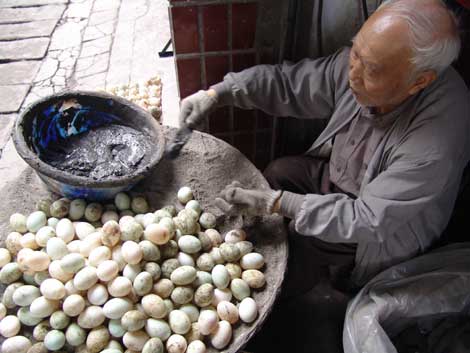Delicacies
Accidental discovery now national favorite
Updated: 2011-07-10 07:48
(China Daily)
|
Traditional methods are still used, but modern methods, simplified, are now more common. Provided to China Daily |
Zhao Yuyi, a 42-year-old worker who has been making century eggs for more than a decade, explains the process that turns normal eggs into the deep, dark delicacy.
Thanks to booming demand, Zhao's company, Qingxu Food Ltd, recently relocated from Henan to the suburbs of Beijing to get closer to their largest market. Qingxu specializes in the manufacturing of lead-free century eggs.
"Century egg sells well in supermarkets and restaurants at home and abroad all year through," Zhao says.
The preserved egg, also known as thousand-year egg or pidan, is made by keeping duck, chicken or quail eggs in a mixture of clay, ash, salt, lime and rice hulls for several weeks to several months. (Never a century!)
Through the process, the yolk becomes a dark green to gray color, with a creamy consistency and a slight whiff of sulfur and ammonia, while the white becomes a dark brown, translucent jelly.
"Some eggs will have patterns on the surface of the egg white that look just like pine branches. So it is also called "songhua dan" (pine-patterned egg)," says Zhao.
Folk history records that the production of century eggs dates back to the Ming Dynasty (1368-1644) in Hunan province, where a resident discovered duck eggs in a pool of leftover slaked lime from the construction of his house two months before.
After tasting the eggs, he decided they were so good he had to make more.
Later, people improved on the method by adding wood ash, quicklime and salt to increase the pH and sodium content of the clay mixture. This addition of natural alkaline compounds speeded up the process and also prevented spoilage.
Zhao says it is more common these days to use a simplified formula for mass production.
The eggs are soaked in a brine of salt, calcium hydroxide and sodium carbonate for 10 days, followed by several weeks of aging wrapped in airtight plastic.
The egg becomes easier to digest because alkali breaks down protein and fat, lowering cholesterol level, according to Zhao.
"Although pidan is not aesthetically pleasing, it does not mean it is unsanitary or poisonous.
"In recent years, pidan manufacturers like us have been making sure that workshops are hygienic and there are no residual heavy metals in the egg."
There are many ways to enjoy century eggs. They can be broken up in small pieces on top of chilled silken tofu, and seasoned with chopped spring onions, sesame oil and soy sauce. Sometimes shredded or pickled ginger is added.
The Shanghainese like to mix it all up, blended chopped century eggs with chilled tofu. The Cantonese will simple slice the eggs into wedges and top them with very thinly sliced pickled ginger.
Another Cantonese specialty is a rice congee with shredded salted pork and century egg. However we eat it, this unlikely delicacy is loved all over China.
You can contact the writer at
liuyujie@chinadaily.com.cn.
E-paper

The perfect cut
Companies need to revamp, standardize to stave off quality challenges
Crowning achievement
Living happily ever after
Let there be smell
Specials

My China story
Foreign readers are invited to share your China stories.

90th anniversary of the CPC
The Party has been leading the country and people to prosperity.

Setting the pace in Turkey
China is building a 158-km high-speed railway in Turkey.

